Calibration Targets

- Microscope Slides & Reticles for Imaging System Calibration
- Soda Lime or UV Fused Silica Substrates with Chrome Plating
R1L3S1P
Stage Micrometer
with 50 µm Divisions
R3L3S3P
Concentric Squares Target,
0.1 mm to 50 mm
R2L2S3P1
Grid Distortion Target,
125 µm Grid Spacing
R1L3S12N
Ronchi Ruling Target,
10 lp/mm Pattern
R3L3S5P
Concentric Circles and Crosshairs Grid Target
R1DS2P
Concentric Circles Reticle

Please Wait
| General Specifications | ||
|---|---|---|
| Optic Type | Slides & Targets | Reticlesa |
| Chrome Thickness | 0.120 µm | |
| Chrome Optical Density | OD ≥3 at 430 nm | |
| Substrate Thickness | 0.06" (1.5 mm) | |
| Surface Flatness | ≤15 µm | N/A |
| Surface Quality | N/A | 60-40 S-D |
| Transmitted Wavefront Error | N/A | <λ at 633 nm |
| Line Spacing Toleranceb | ±1 µm | N/A |
| Line Width Toleranceb | ±0.5 µm | N/A |
| Diameter Tolerance | N/A | +0.0/-0.1 mm |
| Substrate | Soda Lime Glass | UV Fused Silicac |
Quick Links
- Horizontal Stage Micrometers with Divisions from 10 µm to 100 µm (1" x 1" or 3" x 3")
- Concentric Squares with Positive Pattern Sizes from 0.1 mm to 50 mm (3" x 3")
- Single-Frequency Ronchi Ruling Targets (3" x 1")
- Concentric Circles and Crosshairs Grid Target (3" x 3")
- Combined Resolution and Distortion Test Targets (18 mm x 18 mm)
- Grid Distortion Targets (1.5" x 1.5" or 3" x 1")
- Combined Resolution and Distortion Test Target with Stage Micrometers (3" x 1")
- Concentric Circles & Crosshair Reticles (Ø19.0 mm, Ø21.0 mm, or Ø1")
Thorlabs' calibration targets include stage micrometers, concentric squares and circles, distortion targets, and reticles for calibrating an imaging system. Square and rectangular targets feature soda lime glass substrates with vacuum-sputtered, low-reflectivity chrome, while our reticles feature UV fused silica substrates and high-reflectivity chrome. Each pattern is manufactured using photolithography, allowing for edge features to be resolved down to approximately 1 µm.
Mounting
Rectangular calibration targets can be mounted in many of our microscope slide holders, such as general fixed slide holders, microscope slide holders, and translation stages for microscopy. We also offer fixed optic holders for mounting reticles.
| Targets Selection Guide | ||||
|---|---|---|---|---|
| Resolution Test Targets | Calibration Targets | Distortion Test Targets | Slant Edge MTF Target | Stage Micrometers |

Click to Enlarge
Soda Lime Glass Transmission

Click to Enlarge
Spectral Curves of Reflective Test Targets
The large difference between the chrome (blue line) and low-reflectivity chrome (red line) in the visible region means that the positive reflective targets have high contrast between the pattern and the background.
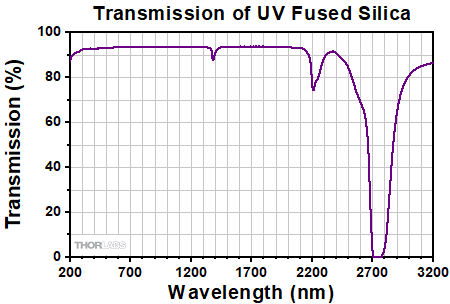
Click to Enlarge
The transmission plot was measured at normal incidence using a UV fused silica substrate that was 1.0 mm thick. The transmission for the reticles sold here will be slightly lower because of their 1.5 mm thickness.
| Customization Parameters | ||
|---|---|---|
| Substrate Sizea | Min | 8 mm x 8 mm (5/16" x 5/16") |
| Max | 85 mm x 85 mm (3.35" x 3.35") | |
| Substrate Materials | Soda Lime Glass UV Fused Silica Quartz |
|
| Coating Material | Chromeb Low-Reflectivity Chromec |
|
| Coating Optical Density | ≥3d or ≥6e @ 430 nm | |
| Minimum Pinhole/Spot | Ø1 µm | |
| Minimum Line Width | 1 µm | |
| Line Width Tolerance | -0.25 / +0.50 µm | |
| Maximum Line Density | 500 lp/mm | |
Custom OEM Test Targets and Reticles
Our in-house photolithographic design and production capabilities enable us to create a range of patterned optics. We manufacture test targets, distortion grids, and reticles at our Thorlabs Spectral Works facility in Columbia, South Carolina. These components have served a wide variety of applications, being implemented in microscopes, imaging systems, and optical alignment setups.
In addition to our catalog test targets and reticles offered from stock, we can provide custom chrome patterns on soda lime, UV fused silica, or quartz substrates from 8 mm by 8 mm up to 85 mm by 85 mm. Substrates can be cut to shape for your application. Our photolithographic coating process allows us to create chrome features down to 1 µm. A few sample patterns are shown below, which can be made positive or negative, as shown in the image directly below.
For a quote on custom test targets and reticles, please contact us at TSW@thorlabs.com.
Sample Patterns
Example Applications
- Etched Reticles
- Gray Scale Masks
- Resolution Reticles
- Diagnostic Reticles
- Recreational Scopes
- Notching Reticles
- Eyepiece Scales
- Illuminated Crosshairs
- Obstruction Targets
- Binocular Reticles

Click to Enlarge
Positive and Negative Crosshair Sample Pattern
This tab details an optimal cleaning technique developed by our engineers for cleaning reticles, test targets, distortion targets, and calibration targets.
Cleaning Procedure
- Use a clean wet sponge, preferably made of polyvinyl alcohol (PVA), and dish detergent to gently scrub the front and back surfaces of your reticle or target.
- Rinse with water.
- Blow dry with clean dry air, or allow the reticle or target to air dry on a clean surface.
We do not suggest using a towel, rag, or wipe to dry the surface. If contamination persists, soak the reticle or target in a detergent and water solution for 1 hour, repeating as necessary.
| Posted Comments: | |
| No Comments Posted |

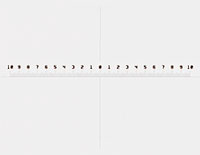
Click to Enlarge
Close Up of the R1L1S5P Horizontal Scale with Crosshair
- 1" x 1" (25.4 mm x 25.4 mm) Stage Micrometer
- For Calibrating Eyepiece Reticles or Objective Magnification
- 20 mm Horizontal Scale with 100 µm Divisions and Crosshair
This target features a stage micrometer pattern with 100 µm divisions and numerical labeling every 1 mm. The pattern is oriented horizontally with a 20 mm long scale and a perpendicular crosshair. The target consists of a 1" x 1" soda lime substrate with low-reflectivity, vacuum-sputtered chrome. This positive target is useful for the calibration of distances within imaging systems.


Click to Enlarge
Microscope Image of R1L3S1P Stage Micrometer
- For Calibrating Eyepiece Reticles or Objective Magnification
- R1L3S1P: 10 mm Scale with 50 µm Divisions
- R1L3S2P: 1 mm Scale with 10 µm Divisions
- Scales Centered on a 3" x 1" (76.2 mm x 25.4 mm) Microscope Slide
These targets each feature a horizontal stage micrometer pattern. The R1L3S1P micrometer has a 10 mm long scale with 50 µm divisions and numerical labeling every millimeter, while the R1L3S2P has a 1 mm long scale with 10 µm divisions and numerical labeling every
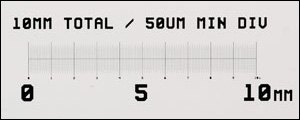
Click for Details
R1L3S1P Under Magnification

Click for Details
R1L3S2P Under Magnification


Click to Enlarge
R3L3S3P Concentric Square Pattern
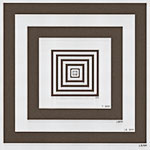
Click to Enlarge
Close Up of the Squares Smaller than 15 mm Wide on R3L3S3P Concentric Square Target
- 3" x 3" (76.2 mm x 76.2 mm) Concentric Square Target
- Calibrate a Measurement for Imaging Software
- Low-Reflectivity, Vacuum-Sputtered Chrome
The R3L3S3P Concentric Square Target features fourteen concentric squares with lengths and widths ranging from 0.1 mm to 50 mm (see table below). Each square is labeled with its width on the target. This target is made from a soda lime glass substrate with low-reflectivity, vacuum-sputtered chrome. These positive targets are useful for the calibration of distances within imaging systems.
|
|


Click to Enlarge
Close Up of R1L3S14N Ronchi Ruling Pattern
| Optical Specifications | |
|---|---|
| Pattern | LRa Chrome |
| Background | Clear |
| Chrome Optical Densityb | ≥3.0 |
- 3" x 1" (76.2 mm x 25.4 mm) Square Wave Ronchi Ruling Target
- Patterns with 10 lp/mm Up to 350 lp/mm
- Large 65 mm x 17 mm Clear Aperture
- Determine Resolution, Field Distortion, and Parfocal Stability in an Optical System
- Low-Reflectivity, Vacuum-Sputtered Chrome on Soda Lime Glass
- Compatible with our MLS203 Microscope Stages via MLS203P2 Slide Holder
Thorlabs offers Ronchi ruling targets with resolutions ranging from 10 line pairs (one light line and one dark line) per millimeter (lp/mm) to 350 lp/mm. These square wave, constant-interval bar and space patterns are fabricated from the deposition of a dark low-reflectivity chrome pattern on a 3.00" x 1.00" x 0.06" (76.2 mm x 25.4 mm x 1.5 mm) soda lime glass substrate. This leaves a large 65 mm x 17 mm clear aperture, and works well in back-lit and highly illuminated applications. The dimensions of the glass substrate are the same as a standard microscope slide. These Ronchi rulings are excellent for evaluating resolution, field distortion, and parfocal stability in optical systems.


Click to Enlarge
Close Up of the Smaller Grid on the R3L3S5P Target with Labels Added (See Tables Below)
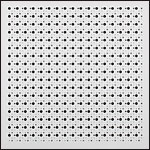
Click to Enlarge
Close Up of Entire Pattern on the R3L3S5P Target
| Optical Specifications | |
|---|---|
| Pattern | LRa Chrome |
| Background | Clear |
| Surface Flatness | ≤15 µm |
| Chrome Optical Densityb | ≥3.0 |
- Concentric Circles and Crosshair Patterns Arranged in a Grid
- Four Different Concentric Circle Sizes and Five Different Crosshair Sizes
- Measure Resolution, Distortion, and Magnification of an Imaging System
- 3" x 3" (76.2 mm x 76.2 mm) Soda Lime Glass Substrate
Thorlabs' 3" x 3" (76.2 mm x 76.2 mm) Concentric Circles and Crosshairs Grid Target offers 289 individual grids, arranged in a larger, 2" x 2" grid of 17 rows and 17 columns. The smaller grids each have four concentric circle patterns and five crosshair patterns of varying sizes. The concentric circle and crosshair patterns on the smaller grids are labeled in the image to the right but not on the target itself. Each concentric circle pattern features seven different radii, while the crosshairs each have a single or a double cross. For details on the dimensions of these patterns, see the tables below.
The pattern on this target is made from plating low-reflectivity, vacuum-sputtered chrome on a 0.06" (1.5 mm) thick soda lime glass substrate to achieve an optical density of ≥3 at 430 nm. The dark pattern and clear substrate are useful for front-lit and general applications.
| Concentric Circles | |||||||
|---|---|---|---|---|---|---|---|
| Circle Patterna | R1 | R2 | R3 | R4 | R5 | R6 | R7 |
| A1 | 31.3 µm | 62.5 µm | 125 µm | 140.6 µm | 234.4 µm | 242.2 µm | 500 µm |
| A2 | 15.6 µm | 31.3 µm | 62.5 µm | 70.3 µm | 117.2 µm | 121.1 µm | 250 µm |
| A3 | 7.8 µm | 15.6 µm | 31.3 µm | 35.2 µm | 58.6 µm | 60.5 µm | 125 µm |
| A4 | 3.9 µm | 7.8 µm | 15.6 µm | 17.6 µm | 29.3 µm | 30.3 µm | 62.5 µm |
| Crosshairs | |||
|---|---|---|---|
| Crosshair Patterna | Single or Double Line | Length/Width | Line Widthb |
| B1 | Double | 500 µm | 6.25 µm |
| B2 | Double | 500 µm | 12.5 µm |
| B3 | Single | 500 µm | 50 µm |
| B4 | Double | 500 µm | 25 µm |
| B5 | Double | 500 µm | 100 µm |

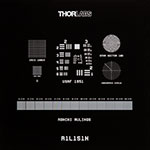
Click to Enlarge
Microscope Image of the R1S1L1N Negative Test Target
| Optical Specifications | ||
|---|---|---|
| Item # | R1L1S1P | R1L1S1N |
| Pattern | LRa Chrome | Clear |
| Background | Clear | LRa Chrome |
| Chrome Optical Densityb | ≥3.0 | |
- Determine Resolution of an Optical System
- Measure Image Distortion, Astigmatism, and Other Aberrations
- 18 mm (0.71") Square, 1.5 mm Thick Soda Lime Substrate
- Includes 1951 USAF Pattern, Sector Star, Concentric Circles, Grids, and Ronchi Rulings
- Positive and Negative Targets Available
Thorlabs offers positive and negative 18 mm x 18 mm x 1.5 mm combined resolution / distortion test targets that are made by plating low-reflectivity, vacuum-sputtered chrome with an optical density (OD) of ≥3.0 at 430 nm on a soda lime glass substrate. They are ideal for the calibration of imaging systems and microscope stages.
The test targets include a 1951 USAF pattern (Groups 2 - 7), a sector star, concentric circles, grids (100 µm, 50 µm, and 10 µm), and Ronchi rulings (30 - 150 lp/mm). These targets are useful for testing resolution, field distortion, focus errors, and astigmatism. The 1951 USAF targets are useful for measuring imaging resolution. The grids can be used to measure image distortion, while the concentric circles are ideal for identifying focus errors, astigmatism, and other aberrations existing in an imaging system. The Ronchi rulings are excellent for evaluating resolution, field distortion, and parfocal stability. For more information, please see our Resolution Targets page.
These resolution targets are offered in positive and negative versions. The R1L1S1P positive target consists of a low-reflectivity chrome pattern plated on to a clear substrate and is useful for front-lit and general applications. Alternatively, the R1L1S1N negative target uses the same low-reflectivity chrome coating to cover the substrate, leaving the pattern itself clear, and works well in back-lit and highly illuminated applications.
| Target Feature | Details | Target Feature | Details |
|---|---|---|---|
| 1951 USAF Target | Groups 2 - 7 | Concentric Circles | 10 Circles with Radii from 100 µm to 1000 µm in 100 µm Intervals, Labeled 1 to 10 |
| Grids | 20 x 20 Arrays with 100 µm, 50 µm, and 10 µm Pitch | Ronchi Rulings | 13 Rulings from 30 lp/mma to 150 lp/mm in 10 lp/mm Intervals |
| Sector Star | 36 Bars through 360°, 10 µm Radius Center Circle, and Ten Concentric Circles with Radii from 50 µm to 500 µm in 50 µm Intervals | ||

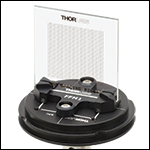
Click to Enlarge
An R2L2S3P3 Target Post Mounted via an FFM1 Filter Mount and a B3C Cube Base for Use in a Custom Imaging System

Click for Details
A Close Up of the Dot Pattern on the R2L2S3P4 Target
- One Grid Array on a 1.5" x 1.5" (38.1 mm x 38.1 mm) Soda Lime Glass Substrate
- 125 µm, 250 µm, 500 µm, or 1000 µm Grid Spacings
- Ø62.5 µm, Ø125 µm, Ø250 µm, or Ø500 µm Dots
- Ideal for Machine Vision Applications of Stage Calibration and Distortion Detection
These distortion grid arrays each feature a single grid of dots fabricated from the deposition of vacuum-sputtered, low-reflectivity chrome on a soda lime glass substrate. The available grid spacings, which are measured from the center of any dot to the center of any adjacent dot, range from 125 µm to 1000 µm, and the dot diameters range from 62.5 µm to 500 µm.
Grid arrays are used to determine the distortion of an imaging system. Ideally, the horizontal and vertical rows of dots should be perpendicular to each other. A distorted image will show the array as bowed; this image can then be used to correct for distortion.
| Item # | Spacinga | Spacing Tolerance |
Dot Size | Dot Size Tolerance |
Pattern | Background | Pattern Sizeb | Pattern Size Tolerance |
Pattern Optical Density |
Substrate Size |
|---|---|---|---|---|---|---|---|---|---|---|
| R2L2S3P1 | 125 µm | ±1 µm | Ø62.5 µm | ±2 µm | Low-Reflectivity Chrome |
Clear | 25.0 mm x 25.0 mm (0.98" x 0.98") |
±4 µm | OD ≥3.0 at 430 nm | 1.5" x 1.5" x 0.06" (38.1 mm x 38.1 mm x 1.5 mm) |
| R2L2S3P2 | 250 µm | Ø125 µm | ||||||||
| R2L2S3P3 | 500 µm | Ø250 µm | 25.4 mm x 25.4 mm (1" x 1") |
|||||||
| R2L2S3P4 | 1000 µm | Ø500 µm |

| Optical Specifications | ||
|---|---|---|
| Item # | R1L3S3P | R1L3S3PR |
| Pattern | LRa Chrome | LRa Chrome |
| Background | Clear | Chrome |
| Chrome Optical Densitya | ≥3.0 | - |
| Reflectanceb | - | LRa Chrome: <10% Chrome: >40% |
- Four Grid Arrays on a 3" x 1" (76.2 mm x 25.4 mm) Soda Lime Glass Slide
- 10 µm, 50 µm, 100 µm, and 500 µm Grid Spacings
- Ideal for Microscopy Applications of Stage Calibration and Distortion Detection
- Same Outer Dimensions as a Standard Microscope Slide
- High Contrast Positive Reflective Target Available
These grid distortion targets feature four arrays of horizontal and vertical lines spaced 10 µm, 50 µm, 100 µm, and 500 µm apart. This pattern is fabricated from the deposition of low-reflectivity, vacuum-sputtered chrome on a 3" x 1" x 0.06" (76.2 mm x 25.4 mm x 1.5 mm) soda lime glass substrate. The dimensions of the glass substrate are the same as a standard microscope slide.
Thorlabs offers two targets composed of a low-reflectivity chrome pattern etched on soda lime glass. The R1L3S3P positive target has the clear soda lime substrate background for for front-lit and general applications, while the R1L3S3PR positive reflective target has a chrome background for high contrast in reflective applications. See the Graphs tab for details.
Grid arrays are used to determine the distortion of an imaging system. Ideally, the horizontal and vertical lines of the grid should be perpendicular to each other. A distorted image will show the lines as bowed; this image can then be used to correct for distortion.

|
|
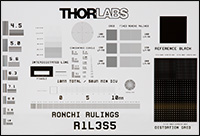
Click to Enlarge
Close Up of R1L3S5P Stage Micrometer
| Optical Specifications | |
|---|---|
| Pattern | LRa Chrome |
| Background | Clear |
| Surface Flatness | ≤15 µm |
| Chrome Optical Densityb | ≥3.0 |
- 3" x 1" x 0.06" (76.2 mm x 25.4 mm x 1.5 mm) Target
- Includes NBS 1963A Pattern, Sector Star, Concentric Circles, Grids, Ronchi Rulings, and More (See Table Below)
- Determine Resolution of an Optical System
- Measure Image Distortion, Astigmatism, and Other Aberrations
- Compatible with our MLS203 Microscope Stages via MLS203P2 Slide Holder
The R1L3S5P positive 3" x 1" x 0.06" (76.2 mm x 25.4 mm x 1.5 mm) combined resolution / distortion test targets that are made by vacuum-sputtering low-reflectivity chrome with an optical density of ≥3 at 430 nm on a soda lime glass substrate. They are ideal for calibration of imaging systems and microscope stages. They are sized to fit in our MLS203P2 stage slide holder for use with our MLS203 microscope stages.
The test targets include an NBS 1963A pattern, a sector (Siemens) star, concentric circles, grids, Ronchi rulings, and more (see table below). These targets are useful for testing resolution, field distortion, focus errors, and astigmatism. The NBS 1963A, sector star, and concentric circle targets are useful for measuring imaging resolution. For more information, please see our Resolution Targets page. The grids can be used to measure the distortion introduced by an imaging system. The Ronchi rulings are excellent for evaluating resolution, field distortion, and parfocal stability.
| Target Feature | Details | Target Feature | Details |
|---|---|---|---|
| NBS 1963A | Frequencies from 4.5 cycles/mm to 228 cycles/mm (See List Above) | Concentric Circles | 10 Circles with Radii from 100 µm to 1000 µm in 100 µm Intervals |
| Distortion Grid (Squares) | 3 Grids: 100 lp/mma, 150 lp/mm, 200 lp/mm | Fixed Ronchi Rulings | 3 Rulings:100 lp/mm, 150 lp/mm, and 200 lp/mm |
| Distortion Grid (Dots) | 3 Grids: 400 µm Pitch of Ø80 µm Dots, 200 µm Pitch of Ø 40 µm Dots, 100 µm Pitch of Ø20 µm Dots |
Variable Ronchi Rulings | 20 Rulings (Each 1 mm x 1 mm): 10 lp/mm to 200 lp/mm in |
| Two-Point Resolution Dots | Ø25 µm, Ø20 µm, Ø15 µm, Ø12.5 µm, Ø10 µm, Ø7.5 µm, and Ø5 µm | Pinholes | Ø25 µm, Ø20 µm, Ø15 µm, Ø12.5 µm, Ø10 µm, Ø7.5 µm, and Ø5 µm |
| Interdigitated Lines | 6.25 lp/mm, 12.5 lp/mm, 25 lp/mm, 50 lp/mm, 100 lp/mm, |
Three Micrometers | 1 mm x 1 mm XY Scale with 50 µm Divisions 1 mm Scale with 10 µm Divisions 10 mm Scale with 50 µm Divisions |
| Sector Star | 36 Bars through 360°, 50 µm Radius Center Circle, and Ten Concentric Circles with Radii from 100 µm to 500 µm in 50 µm Intervals | ||

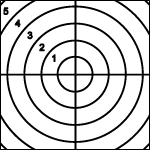
Click for Details
Detail of the Numbered Concentric Circles Pattern (Item # R19DS13P)

Click to Enlarge
R19DS13P in AD19T Mounting Adapter
- Concentric Circles Superimposed on a Crosshair
- Circle Diameter Spacing of 0.5 mm, 1 mm, or 5 mm
- Positive Pattern Available in 19.0 mm, 21.0 mm, and 1" (25.4 mm) Diameters
- Negative Pattern Available in 1" (25.4 mm) Diameter
Our concentric circles reticles consist of a centered crosshair and concentric circles increasing in diameter by 0.5 mm, 1 mm, or 5 mm. The diameters are labeled in 1 mm increments (0.5 mm and 1 mm pitch circles) or 5 mm increments (5 mm pitch circles). The pattern is formed from lines that are 10 µm wide (0.5 mm and 1 mm pitch circles) or 250 µm wide (5 mm pitch circles). Made by plating chrome onto one side of a 1.5 mm thick UV fused silica substrate, these optics provide greater than 90% transmission in the 200 - 1200 nm spectral range.
The Ø19.0 mm reticle can be adapted to Ø1" mounts by inserting it into an AD19T or SM1AD19 Mounting Adapter. The AD19T adapter has a smooth outer perimeter, making it compatible with any standard Ø1" mount, while the SM1AD19 adapter has external SM1 (1.035"-40) threading, providing the ideal match for Thorlabs' line of SM1-threaded optomechanics.


Click for Details
Detail of the Scaled Crosshair Pattern
- Graduated Crosshair Extends to the Edge of the Optic
- Tick Mark Spacings:
- 10 µm up to 1 mm from Center
- 100 µm and 1 mm up to 12 mm from Center
- Positive and Negative Crosshairs Available in 1" (25.4 mm) Diameter
Our scaled crosshair (crossline) reticles are used to superimpose a graduated reference pattern on an object being imaged. The crosshairs span the entire diameter of the optic with a graduated scale of tick marks that go up to 12 mm from center. The first set of tick marks are 2 µm thick and are spaced every 10 µm up to 1 mm from the center (the crosshair is also 2 µm thick within this radius). The next set of tick marks are 10 µm thick and spaced every 100 µm, extending from 1 mm to 12 mm from the center (the crosshair is also 10 µm thick from 1 mm from the center to the edge of the optic). Made by plating chrome onto one side of a 1.5 mm thick UV fused silica substrate, these optics provide greater than 90% transmission in the 200 - 1200 nm spectral range.
The Ø19.0 mm reticle can be adapted to Ø1" mounts by inserting it into an AD19T or SM1AD19 Mounting Adapter. The AD19T adapter has a smooth outer perimeter, making it compatible with any standard Ø1" mount, while the SM1AD19 adapter has external SM1 (1.035"-40) threading, providing the ideal match for Thorlabs' line of SM1-threaded optomechanics.

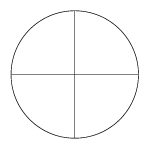
Click for Details
Crosshair Pattern

Click to Enlarge
R19DS11P in SM1AD19 Mounting Adapter
- Crosshair Extends to the Edge of the Optic
- Positive Crosshairs Available in 19.0 mm, 21.0 mm, and 1" (25.4 mm) Diameters
- Negative Crosshairs Available in 1" (25.4 mm) Diameter
- 10 µm or 25 µm Thick Lines
Our crosshair (crossline) reticles are used to superimpose a reference pattern on an object being imaged. The crosshairs span the entire diameter of the optic with lines that are 25 µm or 10 µm (Ø1" optic only) thick. Made by plating chrome onto one side of a 1.5 mm thick UV fused silica substrate, these optics provide greater than 90% transmission in the 200 - 1200 nm spectral range.
The Ø19.0 mm reticle can be adapted to Ø1" mounts by inserting it into an AD19T or SM1AD19 Mounting Adapter. The AD19T adapter has a smooth outer perimeter, making it compatible with any standard Ø1" mount, while the SM1AD19 adapter has external SM1 (1.035"-40) threading, providing the ideal match for Thorlabs' line of SM1-threaded optomechanics.
 Products Home
Products Home






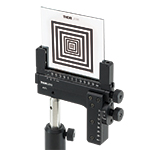

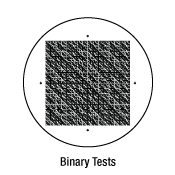 Click to Enlarge
Click to Enlarge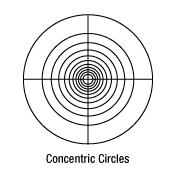 Click to Enlarge
Click to Enlarge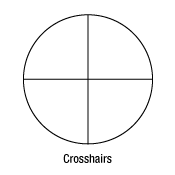 Click to Enlarge
Click to Enlarge Click to Enlarge
Click to Enlarge Click to Enlarge
Click to Enlarge Click to Enlarge
Click to Enlarge Click to Enlarge
Click to Enlarge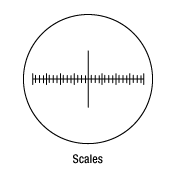 Click to Enlarge
Click to Enlarge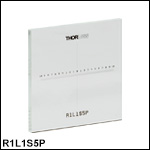
 Zoom
Zoom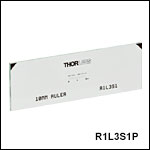
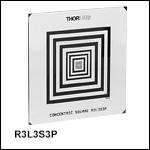
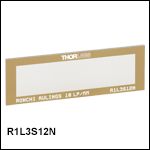



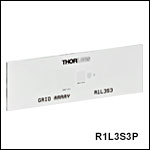
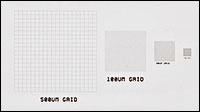

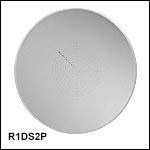

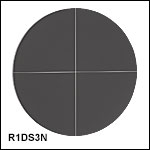
 Calibration Targets
Calibration Targets